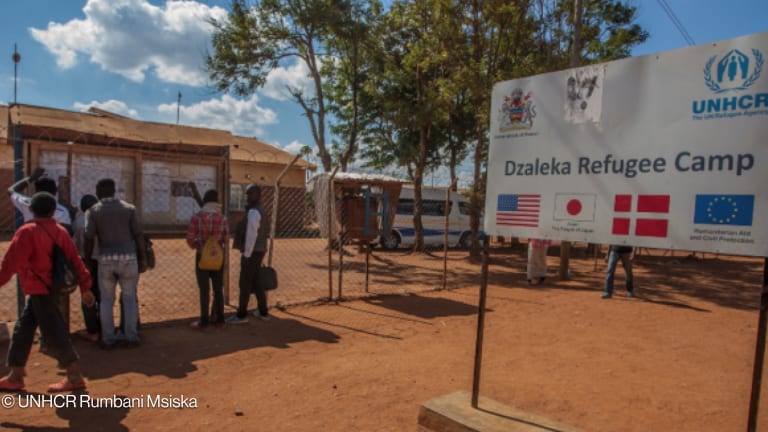
Most humanitarian aid has ground to a halt in Tigray because of the Ethiopian government’s de facto blockade of fuel into the region, which has caused organizations to severely reduce deliveries of lifesaving supplies — including food, water, and medicine — or suspend them entirely. The government has not allowed fuel into Tigray for humanitarian purposes since August, with the exception of two World Food Programme trucks in November.
"We are getting to a critical point, where there's literally nothing left,” said an aid worker who spoke to Devex on condition of anonymity, fearing retribution from the government. “It got to the point where we are just running on fumes or have run out completely.”
The World Health Organization was allowed to take medical supplies into Tigray this month, the first time since July. But the agency released a statement Monday saying it doesn’t have fuel to make distributions to health centers. These supplies, which are only a portion of what’s needed to respond to the health crisis in the region, sit unused in storage.
“If the fuel situation doesn’t improve, it may seriously hamper our ability to work — deepening the suffering of people who have lived through more than a year of conflict.”
— Fatima Sator, public relations officer, International Committee of the Red CrossThe 15-month conflict has left people across Tigray, as well as the neighboring regions of Afar and Amhara, with extensive needs. But the government’s de facto blockade has singled out Tigray, which is home to its adversary: the Tigray People's Liberation Front.
Because of the ongoing conflict and lack of access, aid groups and international agencies haven’t been able to verify the number of people in need within the region, including how many are facing famine conditions. But WFP estimates that 40% of those in Tigray are experiencing “an extreme lack of food.”
Overall, humanitarian organizations need an estimated 200,000 liters (53,000 gallons) of fuel per week for their response activities. As of early February, WFP and other groups providing food assistance had less than 4,000 liters of fuel, not counting limited contingency stocks intended to support emergency evacuation only.
“In Tigray, humanitarian partners are forced to either suspend some response activities or significantly reduce their operations as fuel and supplies stock … are completely depleted or almost entirely exhausted,” according to the United Nations Office for the Coordination of Humanitarian Affairs.
An international humanitarian organization working in Ethiopia, which asked to remain anonymous due to the sensitivity of the situation, told Devex that "the price of the available fuel is at one of the highest peaks since the beginning of the crisis, and we are having to restrict and prioritise movement as a result.”
The group wrote: “Fuel intensive operations, such as water trucking and moving of supplies, are becoming impossible. Water trucking operations will have to be suspended very soon if more fuel is not brought in, which will have significant humanitarian consequences."
Living across 131 sites, about 418,000 Ethiopians displaced within the region need water trucking that requires 295 trips daily and 1,990 liters of fuel. On Feb. 10, the U.N. reported that in the span of a week, water trucking dropped from serving over 143,000 people to just a little over 3,000.
And the health system, already in a state of collapse, is set to be pummeled further.
“We continue to have teams on the ground in Tigray, Afar, and Amhara but are increasingly struggling to maintain our supply chain for essentials like fuel in Tigray,” Fatima Sator, a public relations officer at the International Committee of the Red Cross, told Devex. “If the fuel situation doesn’t improve, it may seriously hamper our ability to work — deepening the suffering of people who have lived through more than a year of conflict.”
At the end of January, ICRC was able to take its first shipment of medical supplies since September into Tigray.
Health workers carrying out a measles campaign reportedly had to walk up to 35 kilometers (22 miles) because of the lack of fuel, staying at homes within communities because they could not travel back each day.
A few months ago, 57 mobile health and nutrition teams were operating in Tigray, according to OCHA, but that figure was reduced to only 18 because of fuel and medicine shortages.
Beyond fuel, the other main operational challenge for aid groups is the ability to take cash into the region. Organizations are operating on credit and unable to pay staffers. The government has shut down banking services in Tigray, and humanitarian organizations need permission to take in even small amounts of cash from Addis Ababa, with multiple layers of bureaucracy and at the risk of denial. Even with that hassle, aid groups have said the cash is nowhere near enough to cover operational expenses.
Recently the government has attempted to “appear more amenable," the anonymous aid worker told Devex. This included allowing more flights into Tigray, such as air shipments of medical supplies. While this is a tangible improvement, it is not enough, and other concessions — such as increased cash allowances into the region, which the government said it would permit — have not materialized, the aid worker said.
Beyond aid deliveries, what the region really needs is for its commercial markets to become functional, according to the aid worker.
“That strangulation of Tigray remains in place,” the aid worker said.








